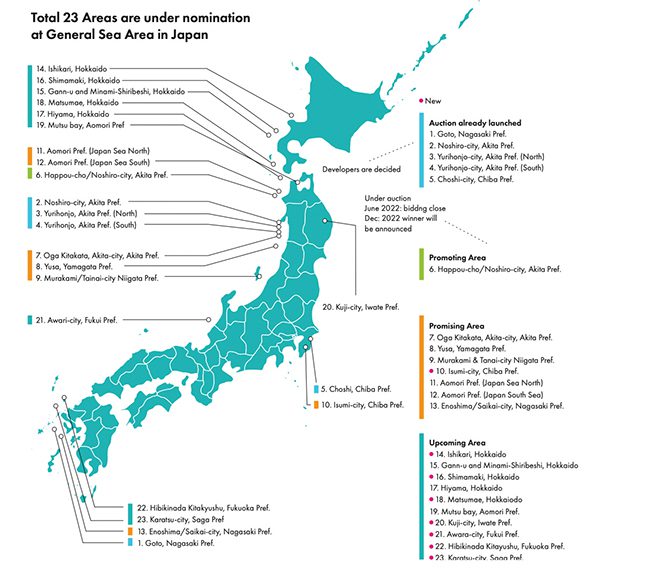Rapid Progress for Japan's Offshore Wind Ambitions
Japan’s ambitions to install up to 10 GW of offshore wind power by 2030 have made rapid progress over the past month, driven partly by accelerated action to address a supply and demand mismatch. Weeks after construction kicked off at the 140-MW Akita Noshiro offshore wind farm—Japan’s first commercial offshore wind farm—Siemens Gamesa Renewable Energy (SGRE) on July 29 reported it received a firm order for the 112-MW Ishikari offshore wind power project.
The Akita Noshiro offshore wind farm in Akita Prefecture in northern Japan will feature 33 Vestas V117-4.2 MW wind turbines when it begins commercial operation as expected at the end of 2022. The consortium of electric utilities and local companies that make up the Akita Offshore Wind Corp. (AOW) formally kicked off construction on July 2. Thirteen wind turbines will be installed at Akita Port, and 20 will be installed at Noshiro Port. The project, estimated to cost 100 billion yen ($746 million), has already secured a 20-year power purchase agreement (PPA) with Tohuku Electric Power Co.
Green Power Investment’s Ishikari offshore wind power project, located 5 kilometers (km) offshore Ishikari Bay in Hokkaido, will feature 14 SG 8.0-167 DD offshore wind turbines, each with a capacity of 8 MW, SGRE said. Installation of the project is slated to begin in July 2023.
An Island With Vast Offshore Potential
According to the Global Wind Energy Council (GWEC), Japan has approximately 128 GW of fixed-bottom offshore wind potential and 424 GW of floating offshore wind potential. “Considering Japan as an archipelago with strong wind speeds—even stronger and steadier offshore—the development of offshore wind is indispensable to increasing renewable energy supplies,” the organization said in its latest global offshore wind outlook. “Despite the huge wind potential, Japan does not have any large-scale commercial wind operations but times are changing.”
Japan’s 6th Energy Strategic Plan, which the Cabinet approved in October 2021, raised its percentage of renewable energy to 36% to 38% by fiscal year 2030. Wind’s share of the total is 5%. Japan’s vision for an offshore wind expansion, however, was unveiled in December 2020. Along with the interim target of 10 GW of offshore wind by 2030, it envisions installations of a combined 30 GW to 45 GW by 2040, along with a cost reduction target by industry of 8 to 9 yen/kWh between 2030 and 2035.
 |
|
1. Since April 2019, Japan has been steadily working on expanding offshore wind generation by creating a certification system and licensed use of designated promotional sea areas. This image from the Global Wind Energy Council’s (GWEC’s) Offshore Wind Report 2022 shows nominated offshore wind areas in Japan’s General Sea Area. Courtesy: GWEC |
So far, Japan has cleared several projects (Figure 1). In June 2021, it selected a consortium of six companies led by Toda Corp. to build Japan’s first floating wind farm offshore Goto City in Nagasaki Prefecture. Meanwhile, consortia led by Mitsubishi Corp. in December 2021 won the rights to develop all three projects offered in Japan’s Round 1 auction for bottom-fixed offshore projects under Japan’s Offshore Wind Promotion Act. Representing an aggregate capacity of 1.7 GW, these projects include zones offshore Noshiro City, Akita Prefecture; Yurihonjo City, Akita Prefecture; and Choshi City, Chiba Prefecture.
The government, however, abruptly suspended a second round of the auction in March for a wind farm offshore Happo-Noshiro, Akita Prefecture. It said in June it planned to resume public auctions by the end of the year after revising auction rules to appeal to a broader range of bidders and accelerate development.
The government is now reportedly mulling new rules for future public auction processes, including preventing a single bidder or consortium from bidding for more than 1 GW of capacity. “Mitsubishi’s success was underpinned by tariff prices well below the ceiling price of 29 yen per kilowatt-hour. This auction result is likely to have led to concerns amongst international developers regarding the low tariff pricing,” noted an alert from law firm Greenberg Traurig in early July.
Facing Tight Power Supplies
Japan’s scramble to add offshore wind to its power profile stems from recent reliability near-misses that have cast new light on its power system’s vulnerability to extreme weather events. The country mulled resuming operation of 10 thermal power plants to ensure electricity security this past summer. It has urged its nuclear fleet to return to service to mitigate tight supplies expected this winter.
Meanwhile, the country is suffering a surge in fuel prices, which stems from tight markets in the wake of Russia’s invasion of Ukraine. In 2021, gas was Japan’s dominant power source, making up about 36% of its generation mix, followed closely by coal at 29%.
“This could come in the form of ramping up power generation from coal, but the market’s current situation requires it to diversify away from fossil fuel use amid carbon emission reduction targets,” it added. “However, other power types are also facing challenges, nuclear’s stringent conditions are delaying the sector’s growth, offshore wind power is still nascent, and the solar power sector is small compared to gas power.”
—Sonal Patel is a POWER senior associate editor (@sonalcpatel, @POWERmagazine).